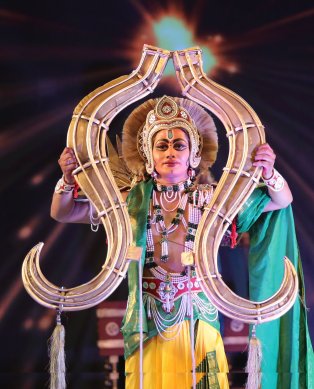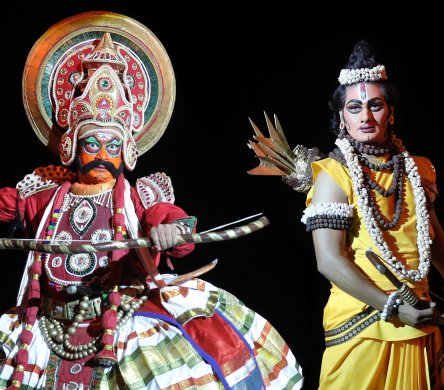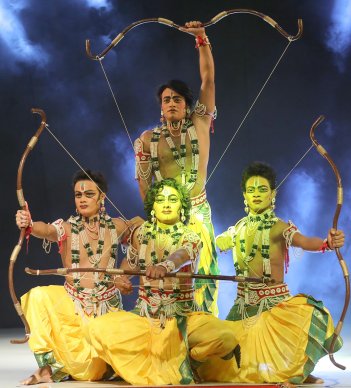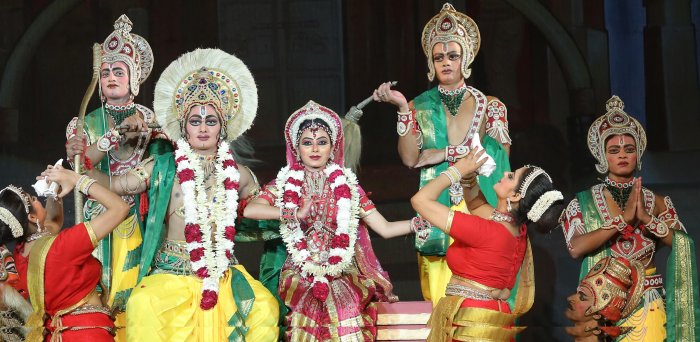
|   |

|   |
 e-mail: sunilkothari1933@gmail.com Shobha Deepak Singh's enthralling dance-drama 'Shri Ram' Photos courtesy: SBKK October 23, 2019 For the past 63 years Sri Ram Bharatiya Kala Kendra's production of Ramleela continues to enchant the audiences. I remember in early fifties whenever I visited New Delhi from Mumbai, during month of October there was always celebrations of Lord Rama. In those years on multiple stages, Narendra Sharma's choreography of Ramleela was staged. Shashidaran Nair used to coordinate and perform, so many actors performed for a long time. Now the new generation of young male and female dancers performs Ramleela under supervision, direction of Shobha Deepak Singh. As a matter of fact, Ramleela of Sri Ram Bharatiya Kala Kendra needs an independent special history. The present production was inaugurated by the Vice President of India, Mr. M Venkaiah Naidu on 29th September at 6pm. That show was exclusive for invitees and had high security arrangements. We managed to go on 5th October and lo and behold, the magic of the present production held us in thrall. Our generation knows Ramayana backwards. Be it Tulasidas's Chaupais, or Sanskrit shlokas from Valmiki's Ramayana, the popular version of Ramayana and the script written by Arvind Kumar and Neelabh 'Ashk', the spell continues and the moment dancers arrive on the stage playing drums and cymbals and singing, you start humming with them. So powerful is the music arrangement that you start soaking yourself in the lyrics penned by contemporary Hindi poets. Says Shobha Deepak Singh: "Our production imbibes the intrinsic unfailing faith and ideals that offer an opportunity for a socially wholesome evolution, portraying principles in an entertaining manner." 'Entertaining' is the key word. Despite the repeated narrations, the portrayal of Ram, his banishment, Sita's unfailing faith despite personal tribulations, the antics of Ravana and several other incidents remain endearing and resonate long after the curtain falls. This year's Ramayana has few interesting departures. Shobha Singh has introduced fresh animation to enhance the audience experience. As an expert costumes designer, she has re-done the costumes, sets and intelligent light systems for an overall enthralling viewing. Singh reiterates: "Life is complex with much to learn. The journey of Ram teaches us that. In this spirit we can continue our journey, sure in the knowledge that behind every action there is purpose and that of divine." I always remember the saying that so long as mountains and rivers flow, Ram's story will continue to spread on this earth for centuries. Our generation has been fortunate to have learnt the story of Ramayana from our elders, we have seen the traditional Ramleela performed in villages, and we have seen the films Bharat Milap and Ram Rajya, which have left deep impression on our minds. When I saw Bharat coming to see Ram and beg him to accompany him back to Ayodhya falling at his feet, tears welled in my eyes and I was emotionally moved. We were seven brothers and the love we saw between Ram and Bharat always remained an ideal for us.  The royal durbar, Vishwamitra visiting King Dasharatha to ask Ram and Lakshmana to protect the yagna he and other rishis are performing, the annihilating of Ravana's sister Tadaka and other demons, touching the stone and coming alive of Ahalya on way back to Jankapuri, the Sita swayamvara, the placing of Shiva's bow, other invited kings' attempts to lift it and meeting with defeat, one also notices that Singh has not brought Ravana in Sita Swayamvara scene. Rama's lifting and breaking the bow, the joyous loud 'Jayjayakar' filling the open air auditorium keeps audience under a spell. Parashuram on learning of Ram's breaking Shiva's bow gets angry, but Ram pacifies him. The scene where Kaikeyi after being instigated by Manthara, ruthlessly asks Dasharatha to fulfill the two promises he had given her, asks him to send Ram to forest for fourteen years and make Bharat the king, is highly dramatic. The actress playing role of Manthara with her wickedness, sly manner, pretending to be most unhappy and laughing when she sees Kaikeyi falling prey to her advice, steals the show. So does the strikingly good looking, attractive dancer playing role of Kaikeyi, enacting ruthlessness and determination not to submit to entire population of Ayodhya begging her to withdraw her promises and let Ram stay back. The collective agony of Ayodhyawasis does not move her. And we see Dasharatha following Raghukula riti sada chali ayi, Pran jayi par vachan na jayi and he dies. All this put up with much power and back projection of animation visually adding to the narrative engages us to watch despite the fact that we know so much of it. But it is presented with so much colour, verve and action that there is not a single dull moment. At times there is too much of colour bursting forth on the screen, which could have been avoided, as sometimes the images duplicating on the screen and the stage defeat the purpose of showing the same action. Despite an interval, one remains tuned to the story performed professionally with ease. After interval we watch Ram, Sita, Lakshmana meeting Kaivat and he ferries them across Ganga - their going by boat is enhanced by back projection of water. The village women perform joyously welcoming them. They stay at Panchavati enjoying the natural beauty when Shurpanakha visits them, making advances to Ram, who tells her to go unto Lakshmana as he has Sita with him and Lakshmana is alone. When Lakshmana cuts her nose and ears, she reveals her demonic form screaming and running to brother Ravana's court. Meanwhile we see Ravana in his court with his soldiers all wearing Sri Lankan masks. Ravana is being entertained by court dancers dressed in white a la Mohiniattam dancers, but performing a mixed style dance, when blood stained screaming Shurpanakha appears and begs of Ravana to take revenge. Ravana knows that a more powerful enemy of his has taken birth and it is his turn to wage a war with him, die and achieve moksha. He orders Maricha to go unto Sita as a golden deer to entice her. Maricha distracts Ram to chase after him, Lakshmana drawing three 'Lakshman rekhas' asking Sita not to cross, runs to save Ram. The projection of subtitles at times helps to see how the narration is abbreviated. Taking advantage of seeing Sita alone, Ravana comes in guise of a sadhu asking alms, kidnaps Sita, encounters Jatayu who attacks him but Jatayu dies. In the interesting back projection we see in chariot flying in the sky, Ravana kidnapping Sita and flying Jatayu attacking Ravana; the technology is employed cleverly transforming into real fighting. Ram and Lakshmana in search of Sita arrive and see wounded Jatayu who tells them Ravana has kidnapped Sita and gone towards Lanka and dies. Ram does the final rites whereby Jatayu achieves moksha. They continue their journey and meet Shabari who offers Ram tested berries, Ram and Lakshmana meet Hanuman who takes them to Sugriva, whose wife has been taken away by Sugriva's elder brother Vali. Ram promises to kill Vali in a combat with Sugriva and Vali. In return, Sugriva with his entire army of monkeys promises Ram to help wage war against Ravana. Vali is killed and Sugriva's son Angad is made the King. Hanuman is sent to Lanka crossing the ocean. The director employs back projection of Hanuman flying across the sea, meeting Sita, giving her Ram's ring, taking Sita's choodamani. Before returning when Ravana ties his tail with cloth and sets fire to it, Hanuman destroys part of Lanka by burning the palaces and mansions. On return he gives choodamani to Ram. During this part the dancers playing roles of monkeys have a field day. They climb the pillar on the stage, frolic around, jump from the stage to the floor of the auditorium, and audience enjoys the fun antics. The Sagardevata is appeased and the stone bridge is built, the stones with name of Ram are shown floating on water in brilliant animation and we see the army of monkeys cross the bridge. 

We then see Ravana reciting his Ravan stotra before Shivalinga, Ram worshipping Goddess Durga before the fight. Terrible fight ensues between Meghnad and Lakshmana, when latter is shot by an arrow of Meghnad and falls in the battle field. Hanuman is sent to bring the aushadhi, medicine from a mountain, and the director shows him flying across the sky bringing the top of the mountain itself. The medicine is applied to revive Lakshmana. The fight ensues between Ram and Ravana and finally Ravana is shot dead with an arrow by Ram. There is jubilation. Before receiving Sita, Ram asks for her to have agnipariksha to show that she is pure. The return is shown in back projection in Pushpaka vimana showing Ram, Sita and Lakshmana in the sky. I think Shobha Deepak Singh has used all the possible tricks using technology to great advantage. There is celebration in Ayodhya. The Mahapattabhishekam is arranged. One sequence of celebration is with natural light, with dancers holding diyas, the lit up lamps all over the stage, and the edges of the stage with tiny bulbs and the entire ambience is so magical that it lingers in one's eyes long after the dance-drama is over.  The coronation with Vashistha rishi placing the crown on Ram's head, Sita seated by his side, Lakshmana and Bharat holding chamars (the flying whisks) and Hanuman at feet, the perfect picture of Rajyabhisheka that one sees in hundreds of calendars all over India, deeply ingrained in one's vision, is indeed breathtaking. The audience gave a standing ovation more in the nature of devotion as the final impact is of devotion. We all say aloud: 'Bolo siyavar Ramchandra ki jai'. The final scene is spectacular and one leaves the lawns of Sri Ram Bharatiya Kala Kendra having witnessed a grand production. The teamwork is praiseworthy. Credits are in order : The actors playing various roles: Ram - Vishnu Avadhesh Kumar / Swapan Majumdar, Lakshmana - Shibhu Ram Mohanta / Rajesh, Vashisth / Ravan - Swapan Majumdar, Janak - Arun / Swapan Majumdar, Dasharatha / Hanuman - Upendra Singh, Parashuram / Valmiki / Meghnath - Shashikant Mohanta, Golden deer - Tarun / Rajesh, Jatayu / Bharat - Anurag Jha, Vali / Sugriva - Neeraj / Vishal Nirman, Kaivat / Vishwamitra - Laxmi Prasad / Vishal, Tadaka - Vishal Nirman. The female artists: Sita / Lakshmi - Anusha Chowdhury / Madhavi Mohanta, Kaikeyi - Madhavi / Tithi / Sanchi, Shurpanakha - Radha Rani / Suchta Das / Tithi, Shabari - Madhu Nag / Sumati Dogra, Manthara - Kusum Tamang / Sumati Dogra. Choreography coordinator is Swapan Majumdar. Dialogues are by Late Manohar Singh, Abhinav Chaturvedi, Shanti Sharma. Vocalists are Shanti Sharma, late Jwala Prasad, Jeetendra Singh, Indu Prakash, Anuradha Nirala, Hameed, Manjeet Singh, Mahesh Pandey. Lighting is by Gautam Bhattacharya with assistance by Banney Singh, Nand Kumar and Ravinder; Stage by Late Keshav Kothari, BK Sawant 'Badal', Sudha Jagannath assisted by Rakesh Pandey. Animation is created by Render Boxx Studio and tailoring by Sohan Lal. Production assistants are Monika, Manju Kohli, Salman and on sound Arvind Pandey. A spectacular, entertaining production, involving an army of artists and technicians did a great job for Sri Ram Bharatiya Kala Kendra.  Dr. Sunil Kothari is a dance historian, scholar, author and critic, Padma Shri awardee and fellow, Sangeet Natak Akademi. Dance Critics' Association, New York, has honoured him with Lifetime Achievement award. Post your comments Please provide your name and email id when you use the Anonymous profile in the blog to post a comment. All appropriate comments posted with name and email id in the blog will also be featured in the site. |